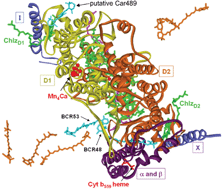Too much light? How β-carotene protects the photosystem II reaction centre†
Abstract
The photosystem II reaction centre of all oxygenic organisms is subject to photodamage by high light i.e. photoinhibition. In this review I discuss the reasons for the inevitable and unpreventable oxidative damage that occurs in photosystem II and the way in which β-carotene bound to the reaction centre significantly mitigates this damage. Recent X-ray structures of the photosystem II core complex (reaction centre plus the inner antenna complexes) have revealed the binding sites of some of the

- This article is part of the themed collection: In honour of James Barber

 Please wait while we load your content...
Please wait while we load your content...